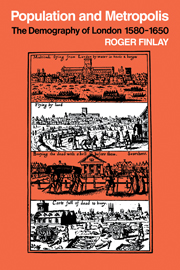Book contents
- Frontmatter
- Contents
- List of tables
- List of figures
- Preface
- 1 Introduction: The magnet of the metropolis
- 2 The accuracy of the London parish registers
- 3 The general growth of population in London
- 4 London social structure in 1638
- 5 The measurement of mortality rates
- 6 The effect of plague on mortality experience
- 7 Marriage and fertility
- 8 Population and metropolis
- Appendix 1 The London bills of mortality
- Appendix 2 Baptisms and burials in sample London parishes
- Appendix 3 Details from the 1638 listing and administrative divisions of London
- Appendix 4 London population in 1631 and houses in 1638 by wards
- References
- Index
- Frontmatter
- Contents
- List of tables
- List of figures
- Preface
- 1 Introduction: The magnet of the metropolis
- 2 The accuracy of the London parish registers
- 3 The general growth of population in London
- 4 London social structure in 1638
- 5 The measurement of mortality rates
- 6 The effect of plague on mortality experience
- 7 Marriage and fertility
- 8 Population and metropolis
- Appendix 1 The London bills of mortality
- Appendix 2 Baptisms and burials in sample London parishes
- Appendix 3 Details from the 1638 listing and administrative divisions of London
- Appendix 4 London population in 1631 and houses in 1638 by wards
- References
- Index
Summary
This is the first study of the population of London during the early modern period and it is also the first detailed book in English about the population of a European metropolitan city at this time. Villages have attracted a good deal of attention from historical demographers but very little is known about larger towns and cities. By the second half of the sixteenth century, London was firmly established as a metropolitan city. Reliable population estimates can first be made from around 1600, when the city numbered about 200,000 inhabitants, a figure which doubled during the first half of the seventeenth century. Because it contained more than 5 per cent of the population of England and was about twenty times the size of the largest provincial cities, London's importance is a recurring theme in the development of English society and economy. It is therefore difficult to study population trends in England without reference to the experience of London.
The analysis in this book is mainly concerned with the internal demography of London. It depends on the application of new techniques in historical demography, principally aggregative analysis and family reconstitution of parish registers, to the study of London population. It has always been thought the London parish registers are insufficiently reliable for this process because of the transient nature of London society and the ineffective compilation of parish registers in a metropolitan city.
Information
- Type
- Chapter
- Information
- Population and MetropolisThe Demography of London 1580–1650, pp. xi - xiiPublisher: Cambridge University PressPrint publication year: 1981
